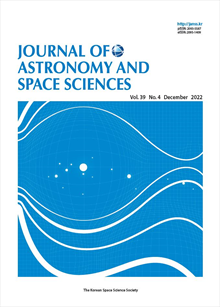간행물
Journal of Astronomy and Space Sciences KCI 등재 SCOPUS

- 발행기관 한국우주과학회
- 자료유형 학술지
- 간기 계간
- ISSN 2093-5587 (Print)2093-1409 (Online)
- 수록기간 1984 ~ 2022
- 주제분류 자연과학 > 천문학 자연과학 분류의 다른 간행물
- 십진분류KDC 443DDC 520
권호리스트/논문검색
제38권 3호 (2021년 8월) 4건
Research Paper
1.
2021.08
서비스 종료(열람 제한)
We describe a method for the in-orbit calibration of body-mounted magnetometers based on the CHAOS-7 geomagnetic field model. The code is designed to find the true calibration parameters autonomously by using only the onboard magnetometer data and the corresponding CHAOS outputs. As the model output and satellite data have different coordinate systems, they are first transformed to a Star Tracker Coordinate (STC). Then, non-linear optimization processes are run to minimize the differences between the CHAOS-7 model and satellite data in the STC. The process finally searches out a suite of calibration parameters that can maximize the model-data agreement. These parameters include the instrument gain, offset, axis orthogonality, and Euler rotation matrices between the magnetometer frame and the STC. To validate the performance of the Python code, we first produce pseudo satellite data by convoluting CHAOS-7 model outputs with a prescribed set of the ‘true’ calibration parameters. Then, we let the code autonomously undistort the pseudo satellite data through optimization processes, which ultimately track down the initially prescribed calibration parameters. The reconstructed parameters are in good agreement with the prescribed (true) ones, which demonstrates that the code can be used for actual instrument data calibration. This study is performed using Python 3.8.5, NumPy 1.19.2, SciPy 1.6, AstroPy 4.2, SpacePy 0.2.1, and ChaosmagPy 0.5 including the CHAOS-7.6 geomagnetic field model. This code will be utilized for processing NextSat-1 and Small scale magNetospheric and Ionospheric Plasma Experiment (SNIPE) data in the future.
2.
2021.08
서비스 종료(열람 제한)
Hyung-Chul Lim, Ki-Pyoung Sung, Mansoo Choi, Jong Uk Park, Chul-Sung Choi, Seong-Cheol Bang, Young-Jun Choi, Hong-Kyu Moon
Apophis is a near-Earth object with a diameter of approximately 340 m, which will come closer to the Earth than a geostationary orbit in 2029, offering a unique opportunity for characterizing the object during the upcoming encounter. Therefore, Korea Astronomy and Space Science Institute has a plan to propose a space mission to explore the Apophis asteroid using scientific instruments such as a laser altimeter. In this study, we evaluate the performance metrics of a laser altimeter using a pseudorandom noise modulation technique for the Apophis mission, in terms of detection probability and ranging accuracy. The closed-form expression of detection probability is provided using the cross correlation between the received pulse trains and pseudo-random binary sequence. And the new ranging accuracy model using Gaussian error propagation is also derived by considering the sampling rate. The operation range is significantly limited by thermal noise rather than background noise, owing to not only the low power laser but also the avalanche photodiode in the analog mode operation. However, it is demonstrated from the numerical simulation that the laser altimeter can achieve the ranging performance required for a proximity operation mode, which employs commercially available components onboard CubeSat-scale satellites for optical communications.
3.
2021.08
서비스 종료(열람 제한)
Alexander Yushchenko, Seunghyun Kim, Yeuncheol Jeong, Aizat Demessinova, Volodymyr Yushchenko, Dmytry Doikov, Vira Gopka, Kyung Sook Jeong, Pakakaew Rittipruk
The dependencies of the chemical element abundances in stellar atmospheres with respect to solar abundances on the second ionization potentials of the same elements were investigated using the published stellar abundance patterns for 1,149 G and K giants in the Local Region of the Galaxy. The correlations between the relative abundances of chemical elements and their second ionization potentials were calculated for groups of stars with effective temperatures between 3,764 and 7,725 K. Correlations were identified for chemical elements with second ionization potentials of 12.5 eV to 20 eV and for elements with second ionization potentials higher than 20 eV. For the first group of elements, the correlation coefficients were positive for stars with effective temperatures lower than 5,300 K and negative for stars with effective temperatures from 5,300 K to 7,725 K. The results of this study and the comparison with earlier results for hotter stars confirm the variations in these correlations with the effective temperature. A possible explanation for the observed effects is the accretion of hydrogen and helium atoms from the interstellar medium.
Technical Paper
4.
2021.08
서비스 종료(열람 제한)
Young-Joo Song, Donghun Lee, Young-Rok Kim, Jonghee Bae, Jae-ik Park, SeungBum Hong, Dae-Kwan Kim, Sang-Ryool Lee
This technical paper deals the practical transformation algorithms between several lunar reference frames which will be used for Korea pathfinder lunar orbiter (KPLO) flight operation. Despite of various lunar reference frame definitions already exist, use of a common transformation algorithm while establishing lunar reference frame is very important for all members related to KPLO mission. This is because use of slight different parameters during frame transformation may result significant misleading while reprocessing data based on KPLO flight dynamics. Therefore, details of practical transformation algorithms for the KPLO mission specific lunar reference frames is presented with step by step implementation procedures. Examples of transformation results are also presented to support KPLO flight dynamics data user community which is expected to give practical guidelines while post processing the data as their needs. With this technical paper, common understandings of reference frames that will be used throughout not only the KPLO flight operation but also science data reprocessing can be established. It is expected to eliminate, or at least minimize, unnecessary confusion among all of the KPLO mission members including: Korea Aerospace Research Institute (KARI), National Aeronautics and Space Administration (NASA) as well as other organizations participating in KPLO payload development and operation, or further lunar science community world-wide who are interested in KPLO science data post processing.

